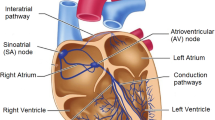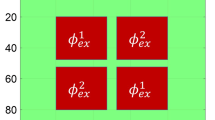Abstract
This work deals with the stimulation of cardiac spiral waves in a two-dimensional FitzHugh–Nagumo model through modulational instability phenomenon in the presence of intracellular magnetic flux. The nonlinear generic model is firstly transformed into a two-dimensional complex Ginzburg–Landau equation with a small real damping term. Then, the latter is explored to perform the linear stability analysis and some modulational instability properties are derived and found to be modified with the change of either the magnetic coupling strength or the diffusion coefficient which are set as the control parameters. The bifurcation theory analysis is numerically performed, and the range of values of the stimulation parameter for which firing patterns emerge in cardiac media is well estimated. The recording of membrane potential as well as the magnetic flux as functions of time or spatial coordinates allows to picture some features such as time series, phase portraits and spatial patterns of membrane potential. As a result, diamond-shaped, squared-shaped and spiral-shaped waves are obtained. An elimination process of multi-spiral waves is proposed by exposing such patterns to an external magnetic flux. Thus, for suited values of parameters, the cardiac spiral waves are transmuted into target waves which obviously protect heart against harmful attacks such as ventricular tachycardia and fibrillation. Our results suggest that uncontrolled electromagnetic induction within cardiac tissue may be considered as the principal source of many heart injuries which are the first cause of mortality in the industrial world.











Similar content being viewed by others
References
Glass, L.: Synchronization and rhythmic processes in physiology. Nature (London) 410, 277 (2001)
Qu, Z., Hu, G., Garfinkel, A., Weiss, J.N.: Nonlinear and stochastic dynamics in the heart. Phys. Rep. 543, 61 (2014)
Scardigli, M., Crocini, C., Ferrantini, C., Gabbrielli, T., Silvestri, L., Coppini, R., Tesi, C., Rog-Zielinska, E.A., Kohl, P., Cerbai, E., Poggesi, C., Pavone, F.S., Sacconi, L.: Quantitative assessment of passive electrical properties of the cardiac T-tubular system by FRAP microscopy. Proc. Natl. Acad. Sci. USA 114, 5737 (2017)
Nash, M.P., Panfilov, A.V.: Electromechanical model of excitable tissue to study reentrant cardiac arrhythmias. Prog. Biophys. Mol. Biol. 85, 501 (2004)
Tusscher, K.T., Noble, D., Noble, P.J., Panfilov, A.V.: A model for human ventricular tissue. Am. J. Physsiol. 286, H1573–H1589 (2004)
Dadivenko, J.M., Pertsov, A., Salomonsz, R., Baxter, W., Jalife, J.: Stationary and drifting spiral waves of excitation in isolated cardiac muscle. Nature 355, 349 (1992)
Winfree, A.T.: Electrical turbulence in three-dimensional heart muscle. Science 266, 1003 (1994)
Witkowski, F.X., Leon, L.J., Penkoske, P.A., Giles, W.R., Spano, M.L., Ditto, W.L., Winfree, A.T.: Spatiotemporal evolution of ventricular fibrillation. Nature 392, 78 (1998)
Abildskov, J.A., Lux, R.L.: The mechanism of simulated torsade de pointes in a computer model of propagated excitation. J. Cardiovasc. Electrophysiol. 2, 224–237 (1991)
Gray, R.A., Jalife, J., Panfilov, A.V., Baxter, W.T., Cabo, C., Pertsov, A.M.: Nonstationary vortexlike reentrant activity as a mechanism of polymorphic ventricular tachycardia in the isolated rabbit heart. Circulation 91, 2454–2469 (1995)
Garfinkel, A., Qu, Z.: Nonlinear dynamics of excitation and propagation in cardiac tissue. In: Zipes, D.P., Jalife, J. (eds.) Cardiac electrophysiology. From cell to bedside, 3rd edn, pp. 315–320. W.B. Saunders Company, Philadelphia (1999)
Difrancesco, D.: Pacemaker mechanisms in cardiac. Annu. Rev. Physiol. 55, 455–472 (1993)
Seemann, G., Höper, C., Sachse, F.B., Dössel, O., Holden, A.V., Zhang, H.: Heterogeneous three-dimensional anatomical and electrophysiological model of human atria. Philos. Trans. A 364, 1465–1481 (2006)
Fox, K.: Resting heart rate in cardiovascular disease. J. Am. Coll. Cardiol. 50, 823–830 (2007)
Fenton, F.H., Karma, A.: Vortex dynamics in three-dimensional continuous myocardium with fiber rotation: filament instability and fibrillation. Chaos 8, 20–47 (1998)
Fenton, F.H., Cherry, E.M., Hastings, H.M., Evans, S.G.: Multiple mechanisms of spiral wave breakup in a model of cardiac electrical activity. Chaos 12, 852–892 (2002)
Karma, A.: Universal limit of spiral wave propagation in excitable media. Phys. Rev. Lett. 66, 2274 (1991)
Karma, A.: Scaling regime of spiral wave propagation in single-diffusive media. Phys. Rev. Lett. 68, 397 (1992)
Krinsky, V., Pumir, A.: Models of defibrillation of cardiac tissue. Chaos 8, 188 (1998)
Winfree, A.T.: When Time Breaks down. Princeton University Press, Princeton (1987)
Fenton, F.H., Cherry, E.M., Karma, A., Rappel, W.J.: Modeling wave propagation in realistic heart geometries using the phase-field method. Chaos 15, 013502 (2005)
Luther, S., Fenton, F.H., Kornreich, B.G., Squires, A., Bittihn, P., Hornung, D., Zabel, M., Flanders, J., Gladuli, A., Campoy, L., Cherry, E.M., Luther, G., Hasenfuss, G., Krinsky, V.I., Pumir, A., Gilmour Jr., R.F., Bodenschatz, E.: Low-energy control of electrical turbulence in the heart. Nat. Lett. 475, 235–239 (2011)
Fenton, F.H., Cherry, E.M.: Models of cardiac cell. Scholarpedia 3, 1868 (2008)
Hodgkin, A.L., Huxley, A.F.: A quantitative description of membrane current and its application to conduction and excitation in nerve. J. Physiol. 117, 500–544 (1952)
FitzHugh, R.: Impulses and physiological states in theoretical models of nerve membrane. Biophys. J. 1, 445–466 (1961)
Nagumo, J.S., Arimoto, S., Yoshizawa, S.: An active pulse transmission line simulating nerve axon. Proc. IRE 50, 2061 (1962)
Aliev, R.R., Panfilov, A.V.: A simple two-variable model of cardiac excitation. Chaos Solitons Fractals 7, 293–301 (1996)
Hindmarsh, J.L., Rose, R.M.: A model of the nerve impulse using two first-order differential equations. Nature 296, 162 (1982)
Hindmarsh, J.L., Rose, R.M.: A model of neuronal bursting using three coupled first order differential equations. Proc. Royal Soc. Lond. B Biol. Sci. 221, 87 (1984)
Morris, C., Lecar, H.: Voltage oscillations in the barnacle giant muscle fiber. Biophys. J. 35, 193 (1981)
Gizzi, A., Loppini, A., Ruiz-Baier, R., Ippolito, A., Camassa, A., La Camera, A., Emmi, E., Di Perna, L., Garofalo, V., Cherubini, C., Filippi, S.: Nonlinear diffusion and thermo-electric coupling in a two-variable model of cardiac action potential. Chaos 27, 093919 (2017)
Fenton, F.H., Gizzi, A., Cherubini, C., Pomella, N., Filippi, S.: Role of temperature on nonlinear cardiac dynamics. Phys. Rev. E 87, 042717 (2013)
Karma, A.: Spiral breakup in model equations of action potential propagation in cardiac tissue. Phys. Rev. Lett. 71, 1103 (1993)
Karma, A.: Electrical alternans and spiral wave breakup in cardiac tissue. Chaos 4, 461–472 (1994)
Tanskanen, A.J., Alvarez, L.H.R.: Voltage noise influences action potential duration in cardiac myocytes. Math. Biosci. 208, 125–146 (2007)
Rostami, Z., Jafari, S., Perc, M., Slavinec, M.: Elimination of spiral waves in excitable media by magnetic induction. Nonlinear Dyn. 94, 679–692 (2018)
Wu, F., Wang, C., Xu, Y., Ma, J.: Model of electrical activity in cardiac tissue under electromagnetic induction. Sci. Rep. 6, 28 (2016)
Ma, J., Wu, F., Hayat, T., Zhou, P., Tang, J.: Electromagnetic induction and radiation-induced abnormality of wave propagation in excitable media. Physica A 486, 508 (2017)
Fu, Y.-X., Kang, Y.-M., Xie, Y.: Subcritical hopf bifurcation and stochastic resonance of electrical activities in neuron under electromagnetic induction. Front. Comput. Neurosci. 12, 6 (2018)
Kuramoto, Y.: Chemical Oscillations, Waves and Turbulence. Springer, Berlin (1984)
Aranson, I.S., Kramer, L.: The world of the complex Ginzburg–Landau equation. Rev. Mod. Phys. 74, 99 (2002)
GarcÍa-Morales, V., Krischer, K.: The complex Ginzburg–Landau equation: an introduction. Contemp. Phys. 53, 79–95 (2012)
Zykov, V.S.: Spiral waves and dissipative solitons in weakly excitable media. Lect. Notes Phys. 751, 453–473 (2008)
Tabi, C.B.: Fractional unstable patterns of energy in \(\alpha \)-helix proteins with long-range interactions. Chaos Solit. Fract. 116, 386–391 (2018)
Mimshe, J.C.F., Tabi, C.B., Edongue, H., Ekobena, H.P.F., Mohamadou, A., Kofané, T.C.: Wave patterns in \(\alpha \)-helix proteins with interspine coupling. Phys. Scr. 87, 025801 (2013)
Tabi, C.B., Ondoua, R.Y., Ekobena, H.P., Mohamadou, A., Kofané, T.C.: Energy patterns in coupled \(\alpha \)-helix protein chains with diagonal and off-diagonal couplings. Phys. Lett. A 380, 2374–2381 (2016)
Zanga, D., Fewo, S.I., Tabi, C.B., Kofané, T.C.: Modulational instability in weak nonlocal nonlinear media with competing Kerr and non-Kerr nonlinearities. Commun. Nonlinear Sci. Numer. Simul. 80, 104993 (2020)
Panguetna, C.S., Tabi, C.B., Kofané, T.C.: Electronegative nonlinear oscillating modes in plasmas. Commun. Nonlinear Sci. Numer. Simul. 55, 326–337 (2018)
Panguetna, C.S., Tabi, C.B., Kofané, T.C.: Low relativistic effects on the modulational instability of rogue waves in electronegative plasmas. J. Theor. Appl. Phys. 13, 237–249 (2019)
Tabi, C.B., Etémé, A.S., Mohamadou, A., Kofané, T.C.: Oscillating two-dimensional \(\text{ Ca }^{2+}\) waves in cell networks with bidirectional paracrine signaling. Waves Rand. Comp. Med. (2019). https://doi.org/10.1080/17455030.2019.1644465
Xu, D., Roth, B.J.: The magnetic field produced by the heart and its influence on MRI. Math. Prob. Eng. 2017, 3035479 (2017)
Raghavachari, S., Glazier, J.A.: Waves in diffusively coupled bursting cells. Phys. Rev. Lett. 82, 2991 (1999)
Cross, M.C., Hohenberg, P.C.: Pattern formation outside of equilibrium. Rev. Mod. Phys. 65, 851 (1993)
Malomed, B.A.: Complex Ginzburg–Landau Equation, in Encyclopedia of Nonlinear Science, pp. 157–160. Routledge, New York (2005)
Mohamadou, A., Ayissi, B.E., Kofané, T.C.: Instability criteria and pattern formation in the complex Ginzburg–Landau equation with higher-order terms. Phys. Rev. E 74, 046604 (2006)
Tiofack, C.G.L., Mohamadou, A., Kofané, T.C., Moubissi, A.B.: Generation of pulse trains in nonlinear optical fibers through the generalized complex Ginzburg–Landau equation. Phys. Rev. E 80, 066604 (2009)
Ndzana II, F., Mohamadou, A., Kofané, T.C., English, L.Q.: Modulated waves and pattern formation in coupled discrete nonlinear LC transmission lines. Phys. Rev. E 78, 016606 (2008)
Kengne, E., Chui, S.T., Liu, W.M.: Modulational instability criteria for coupled nonlinear transmission lines with dispersive elements. Phys. Rev. E 74, 036614 (2006)
Wamba, E., Mohamadou, A., Kofané, T.C.: Modulational instability of a trapped Bose–Einstein condensate with two- and three-body interactions. Phys. Rev. E 77, 046216 (2008)
Kevrekidis, P.G., Carretero-Gonzalez, R., Theocharis, G., Frantzeskakis, D.J., Malomed, B.A.: Stability of dark solitons in a Bose–Einstein condensate trapped in an optical lattice. Phys. Rev. A 68, 035602 (2003)
Akers, B.F.: Modulational instabilities of periodic traveling waves in deep water. Physica D 300, 26–33 (2015)
Göktepe, S., Wong, J., Kuhl, E.: Atrial and ventricular fibrillation: computational simulation of spiral waves in cardiac tissue. Arch. Appl. Mech. 80, 569–580 (2010)
Clayton, R., Zhuchkova, E., Panfilov, A.: Phase singularities and filaments: simplifying complexity in computational models of ventricular fibrillation. Prog. Biophys. Mol. Biol. 90, 378 (2006)
Koplan, B.A., Stevenson, W.G.: Ventricular tachycardia and sudden cardiac death. Mayo Clin. Proc. 84, 289 (2009)
Ma, J., Jia, Y., Yi, M., Tang, J., Xia, Y.-F.: Suppression of spiral wave and turbulence by using amplitude restriction of variable in a local square area. Chaos Solitons Fract. 41, 1331–1339 (2009)
Etémé, A.S., Tabi, C.B., Mohamadou, A., Kofané, T.C.: Elimination of spiral waves in a two-dimensional Hindmarsh–Rose neural network under long-range interaction effect and frequency excitation. Physica A 533, 122037 (2019)
Baysal, V., Yilmaz, E.: Effects of electromagnetic induction on vibrational resonance in single neurons and neuronal networks. Physica A 537, 122733 (2020)
Acknowledgements
The work by CBT is supported by the Botswana International University of Science and Technology under the Grant DVC/RDI/2/1/16I (25). I thank the Kavli Institute for Theoretical Physics (KITP), University of California Santa Barbara (USA), where this work was supported in part by the National Science Foundation Grant No. NSF PHY-1748958, NIH Grant No. R25GM067110, and the Gordon and Betty Moore Foundation Grant No. 2919.01.
Author information
Authors and Affiliations
Corresponding author
Ethics declarations
Conflict of interest
The authors declare that they have no conflict of interest.
Additional information
Publisher's Note
Springer Nature remains neutral with regard to jurisdictional claims in published maps and institutional affiliations.
Rights and permissions
About this article
Cite this article
Tabi, C.B., Etémé, A.S. & Kofané, T.C. Unstable cardiac multi-spiral waves in a FitzHugh–Nagumo soliton model under magnetic flow effect. Nonlinear Dyn 100, 3799–3814 (2020). https://doi.org/10.1007/s11071-020-05750-z
Received:
Accepted:
Published:
Issue Date:
DOI: https://doi.org/10.1007/s11071-020-05750-z




